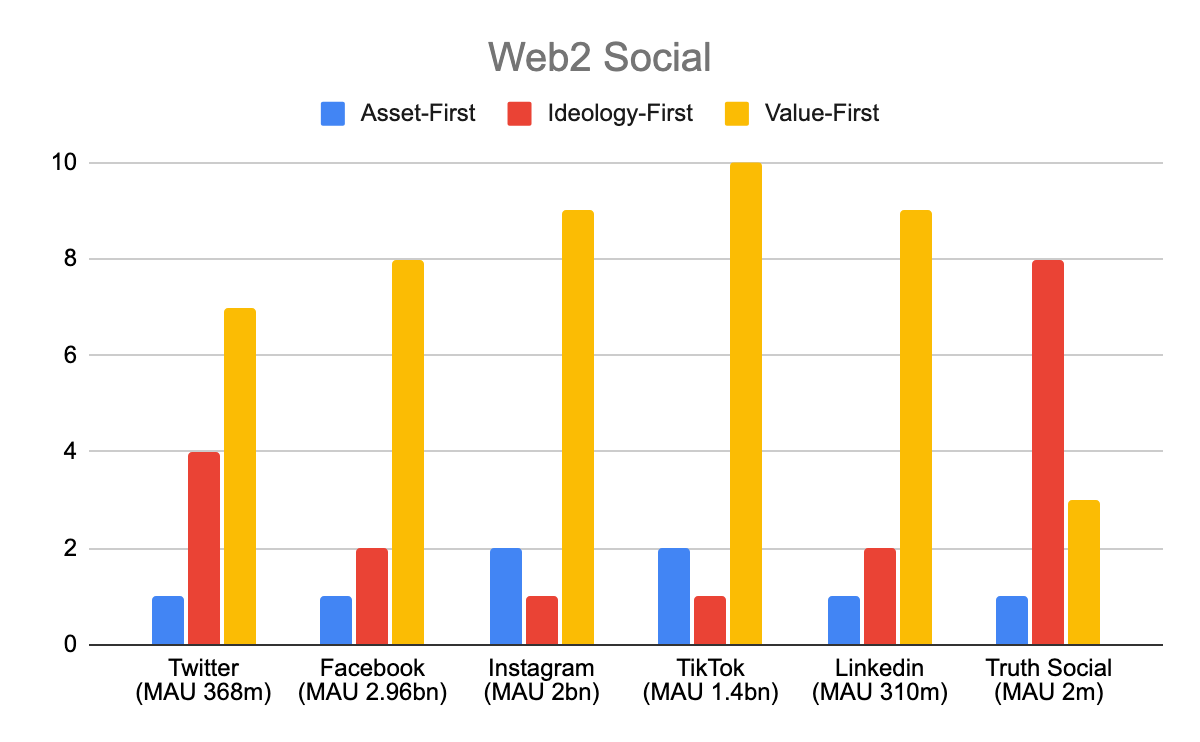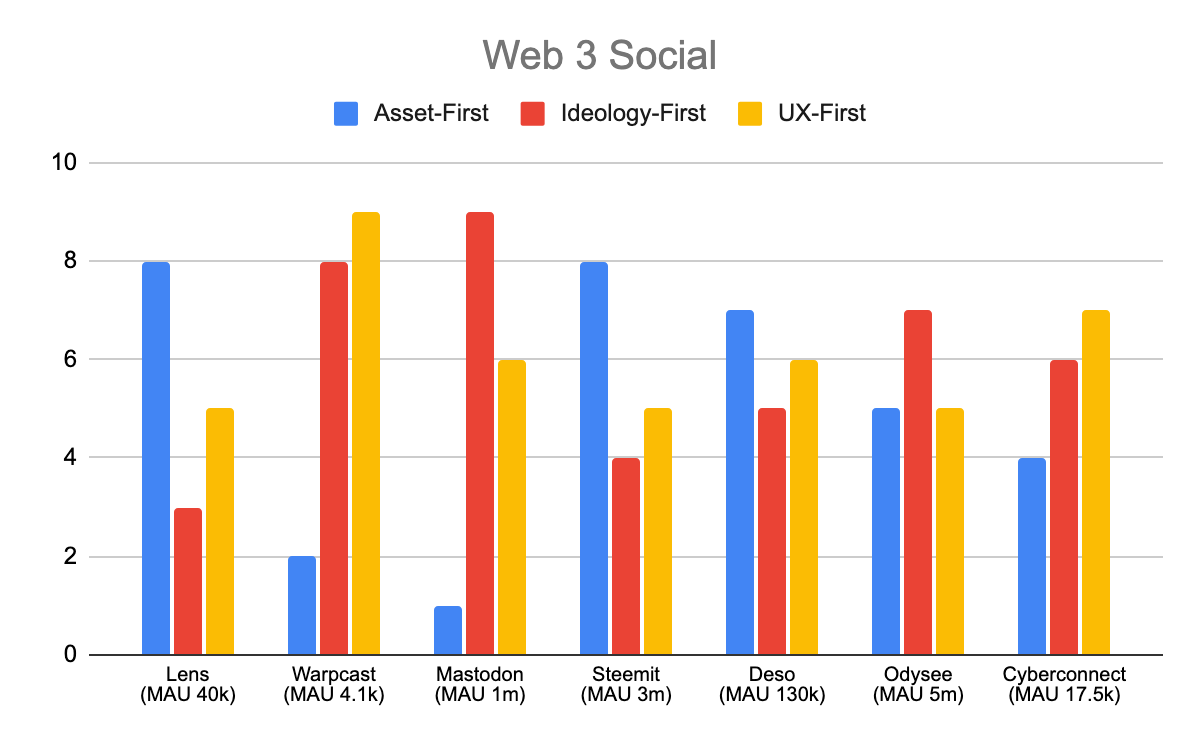Web3 Social: A UX-First Approach
Asset, Ideology, and Experience: Examining Three Approaches

There are two approaches to web3 social posited by Li Jin, formerly of a16z, now co-Founder & GP of Variant.
The asset-first approach prioritises financial incentives and ownership of digital assets within the social experience. This may include incorporating NFTs, crypto tokens, virtual goods, or digital collectibles. Users are incentivized by potential profits from trading/holding assets, this appeals to users' financial motivations primarily.Engagement is driven by speculative interest and asset appreciation with value accruing in users' wallets through market dynamics. Examples include BitClout, Lens Protocol, Steemit, and Stealcam.
The ideology-first approach prioritises users’ ideals, leading with decentralization, privacy, security, plus censorship-resistance by leveraging blockchain architecture and trustless protocols. This appeals to users' principles around freedom of expression, transparency, and control with engagement primarily driven and supporting the ecosystem. Value accrues through upholding human credos encoded in the protocols with the social experience itself potentially closely resembling centralized platforms. Examples include Bluesky, Odysee, and Mastodon.
I posit a third.
The UX-first approach prioritizes user experience seeking to deliver core user value by solving pain points and creating delightful experiences. The crypto/web3 elements serve to enhance the core value proposition, via an approach which embraces the idea that novel tech alone won't drive adoption. The product experience comes first. Crypto features can then augment it. For social, this could mean focusing first on community building, content creation/sharing, discussions etc before layering on trustless protocols and token-based incentives that then add value like privacy, portability, community governance, monetization opportunities. Examples include Farcaster (warpcast), Minds, and Cyberconnect.

Convenience shapes user behaviour, it “decides everything” according to Twitter co-founder Evan Williams. Threads is evidence of this, reaching 100m users in five days, leveraging ease of portability and interoperability within the Meta ecosystem to:
Leverage a pre-existing notification system to drive network effects by prominently displaying the activity of users’ contacts and influencers
Enforce user lock-in via a mechanism whereby you can only delete threads if you delete instagram to mitigate churn
Diversify online user presence optionality along less (perceived) ideological lines than counterparts like twitter
WhatsApp's early growth was fueled by automatically scanning user phonebooks to instantly connect them with friends already on the platform. Nothing manual. Slack's integrations with other work apps brought convenience through interoperability. Users access tools like Google Drive, Trello, etc without switching apps. Increased utility & stickiness.
The UX-first approach acknowledges this phenomenon, and anticipates a flippening (or inflection) for web3 native social apps relative to web2 ones when the tooling underpinning their differentiation is additive to this core objective. As opposed to being primarily driven by tokenomics or ideological motivations.
Note: The asset-first, ideology-first, and value-first scores assigned to the social platforms below are subjective estimates for illustrative purposes only. They do not constitute investment advice or any endorsement of an approach by the platforms themselves. The comparative scoring is meant to provide a conceptual framework for analysis using publicly available information, but may not precisely reflect the platforms' perspectives or goals. Perform your own assessment before relying on these figures. The rankings are based on available public information and may differ from each platform's internal assessment. Please take these figures as directional only.

Twitter MAU: www.businessofapps.com/data/twitter-statistics
Insta MAU: www.businessofapps.com/data/instagram-statistics
Meta/Fb MAU: www.statista.com/statistics/264810
TikTok MAU: www.businessofapps.com/data/tik-tok-statistics
Linkedin MAU: https://99firms.com/blog/linkedin-statistics/
TruthSocial MAU: https://earthweb.com/how-many-people-use-truth-social/

Mastodon MAU: https://www.bankless.com/the-status-of-web3-social
Farcaster MAU: https://farcaster.network/
Lens MAU: https://dune.com/kimi/lens-protocol
Deso, formerly Bitclout, MAU: https://www.bankless.com/the-status-of-web3-social
Cyberconnect MAU: https://www.bankless.com/the-status-of-web3-social
Steemit & Odysee MAU: https://focusonbusiness.eu/en/news/odysee-s-mau-of-5-3-million-makes-it-the-most-popular-decentralized-social-media-platform-in-2023/5576
Viable Metrics for comparing social platforms across these these approaches might be aggregated across the following measures:
Ideology-First Metrics
% of on-chain/off-chain data storage - measures decentralization
Encryption methods used - proxies for privacy
Moderation transparency stats
Blockchain governance mechanisms
Censorship resistance benchmarks
User control of data (editability, transparency, portability)
UX-First Metrics
Retention and engagement rates
User satisfaction/Net Promoter Scores
Active user to total user ratios
Interoperability with other web3 apps and networks
Feature usage data
Asset-First Metrics
% of users that are token holders
Revenue from token transactions
Ratio of financial features to non-financial
Asset holding concentrations - inequality metrics
Correlation between token activity and engagement
Native asset yield opportunities

Temporal View
To win long term, early-stage adherence to decentralization principles could establish the legitimacy required for subsequent integration of frictionless user experiences. Alternatively, initial financial incentives may stimulate network effects and rapid user acquisition at scale, enabling platforms to subsequently focus resources on maximizing retention through convenience. Incumbents acquiring web3 capabilities, as the public warms to crypto, also appears a viable pathway. Defensibility may correlate to approach, with ideology-first principles engendering loyalty, asset-first susceptible to copying, and UX-first contingent on execution.
Optimal sequencing likely varies based on app or protocol type. Ideology transitioning to UX suits utilities like social governance. Asset monetization kickstarting engagement before maximizing retention with user experience fits entertainment platforms.
Connect
Farcaster @papa — https://www.discove.xyz/@papa
Lens @papajams — https://lenster.xyz/u/papajams
Twitter @papajimjams — https://twitter.com/papajimjams



Finger in the air stuff estimating metrics here to extend @li's web3 social asset-first vs ideology-first model. Added a new dimension, UX-first, which farcaster scored higher on than the others in my (and claude's) book. Mini rabbit hole for more: https://paragraph.xyz/@papajams.eth/web3-social-a-ux-first-approach